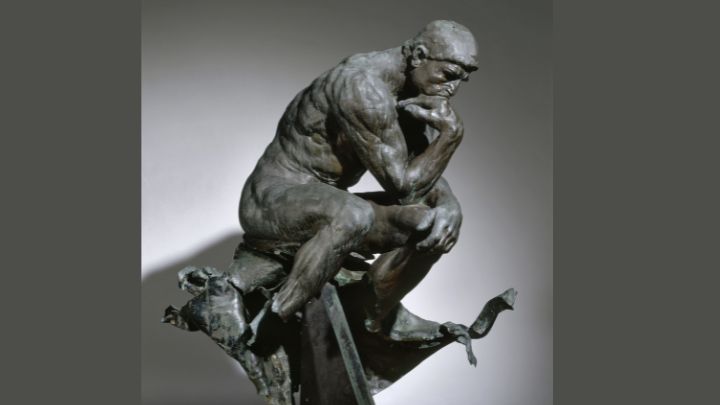I recently had the opportunity to
take my family, along with some close family friends, to visit Washington, D.C.
And interestingly, the same question was posed in two different places that we
visited: What makes us human? One place was the Museum of Natural History and
the other was the Museum of the Bible. Though each museum has a drastically
different worldview as a starting point – the Museum of Natural History is
atheistic and the Museum of the Bible is theistic – they both, in a way, answered
the question similarly, but with a very different explanation as to how that
came to be.
According to the Museum of Natural
History, being human involves things like making tools, communicating in
written form, and showing creativity in ways like crafting instruments and making
art. According to the Museum of the Bible, humans are different from other
creatures because of our sense of morality to determine what is fair and just,
our spirituality and worship, our ability to storytell, and our unique accumulation
of knowledge and culture.
While they focus on different
things, both museums have drawn very similar conclusions. Humans have different
characteristics than any other animal, most of which is explained by our cognitive
abilities. We have an ability to have complex and theoretical thinking,
creativity for the sake of creativity, and ingenuity. However, these museums
have very different explanations as to why that is the case.
The Museum of the Bible credits
these features to the fact that humans were made in the image of God. Our sense
of morality, intelligence, and creativity is because our Creator has those
attributes. Our Creator is moral, intelligent, and creative and chose to impart
those things onto humans alone. The Museum of Natural History, however,
attempts to explain all of these uniquely human features as the result of Darwinian
evolution. But could evolution really be responsible for advancements like
this?
The Museum of Natural History certainly
wants everyone to think so. In nearly every square foot of the museum, the
repeated mantra of “It evolved!” is emblazoned on the walls. Ironically though,
no explanation was given as to how anything evolved, just that it did. In
typical fashion, each exhibit relied on circular logic as a ruse of proving its
point. Instead of giving evidence to prove its premise, it places the
conclusion in the premise to simply give the appearance of proof.
As a simplified example, it would
be something like, “He was a great communicator because he had the knack of
talking effectively to the people.” The conclusion is stated in the premise,
but nothing is actually proven logically.
At the Museum of Natural History,
it looked like this: “Animal A has evolved an exceptional feature XYZ that
allows it to survive in its environment. Clearly evolution works because Animal
A has this particular feature that allowed it to survive.”
The missing link, however, is the
explanation as to how Animal A incrementally over time, through millions
of slight successive modifications, could have evolved this feature, all
while surviving for millions of years without it.
The museum was replete with
fascinating examples of unique features of different organisms that allow them
to survive, such as how a giraffe can bend down to drink water without choking
due to special neck valves to regulate blood flow, or how platypuses can “see”
in muddy water with electrical receptors in their bills, or even how seals are
able to stay warm and buoyant in cold waters due to blubber.
For each of these, and every
example given in the museum, the word “evolved” is simply attached to the
description of the feature. But each example begs explanation. How did the
giraffe drink water before the neck valves evolved? What was the
platypus doing before it had electrical receptors in its bill? How did
the seal survive in the arctic waters while it waited to evolve blubber?
It underscores the major flaw of
Darwinian evolutionary theory. Each of these animals had to survive and
reproduce long before these special features for survival were present. And
since these features are all necessary for survival, these organisms could not
survive or reproduce without them.
Darwinian evolution is based on
random genetic mutations that result in some new feature that increases the
survivability of an organism. In fact, this new feature must be so advantageous
that it results in the extinction of all other organisms that do not have that
particular feature. The lucky organism with that feature would then be the most
fit to survive and pass on that new genetic mutation to future generations,
thus propelling the species into a “better” version of itself.
However, each feature may require
hundreds of components in order to work. Yet under the idea of Darwinian
evolution, all of those components cannot evolve at the same time. Each change
must be, in Darwin’s words, “infinitesimally small,” or through the process of “slight,
successive modifications” on a simple design. There can be no large, en
masse changes to the organism. After all, that would look like creation. It
must be the slow build up from something simple by making slight, individual
changes a little at a time.
If we relate this back to our
original question, what does it mean to be human, we must wonder what path
evolution would have taken in order to produce those uniquely human things in
humans, especially when, according to evolutionists, human-like creatures
survived for millions of years without those human-like characteristics.
I find this particular aspect
interesting to consider. Though evolutionists have named numerous species that
are on the evolutionary path to becoming modern-man, it is curious how any of
them survived to evolve to modern man. If we take away the complex thinking
ability of humans, it is baffling that any human-like creature could have
survived for millions of years.
According to evolutionists, the
first “human-like” species could only walk upright, supposedly 6 million
years ago. In other words, this human ancestor couldn’t do anything else
human-like except bipedal movement. This species apparently survived in this
manner for 3.5 million years before it figured out how to make tools and
survived an additional 2 million years before it lived in communities,
developed a brain of any significance, and was able to communicate.
Imagine a creature that could walk
upright, but had no fur or protective exoskeleton, no claws or self-defense
features, no camouflage ability, is not particularly fast, and is unable to
climb trees or fly. It has no ability to fashion tools or weapons for hunting and
still doesn’t yet have enough brain capacity to figure out how to farm. This
creature isn’t even capable enough to fashion a shelter or clothing, yet it has
no natural way to protect itself from the environment. How is this species
surviving like this for 4 million years?
Granted, the evolutionists would
claim that these human ancestors still maintained all of the ape characteristics
that allowed it to survive. But in order to start becoming more like modern
humans, these ancestral creatures had to lose all of those ape-like
features from random genetic mutations while not yet able to have the cognitive
abilities of modern humans.
Many of these unique human
characteristics are the result of higher-level thinking. The ability to make
tools, to communicate in written form, and to have creativity for arts and
music all are connected to a thinking level that is truly unique to humankind. Granted,
there are animals who exhibit higher levels of thinking than others (it is
evident that dolphins show more thought processing skills than earthworms). However,
the critical thinking skills of humans are on an entirely different level. And
while I’m sure your dog is vastly smarter than all other dogs, there is a
limit, or boundary, to what those thoughts could entail. And it falls woefully
short of human thought.
So how could humans achieve this
different level of thinking? If it is the result of evolution, then it means
that a random genetic mutation must occur which allowed an organism to think on
a higher level than previous generations. At first glance, it appears that
could happen. Our current generation obviously understands rocket science much
better than, say, the generation from the 1800s, but the increase in knowledge
on a subject is not the same thing as an increase in the ability to think
critically. (In fact, some could rightfully say while our knowledge on things
has increased over time it appears our ability to think critically has actually
gotten worse.)
Darwinian evolution must
demonstrate that an error in replicating the organism’s genetic code could
result in an increase of capability in the organism. It is already
difficult to conjecture that decreased genetic information could produce new,
advantageous structural features. It is even less likely that decreased genetic
information could produce new information and cognitive abilities.
Both museums acknowledge humans
exhibit these unique traits of higher-level thinking, creativity, and
reasoning. But the explanation given by the Museum of Natural History fails to
adequately explain how that came to be. Darwinian evolution, relying on random,
genetic mutations and slight, successive modifications to an individual
organism, cannot produce this higher level of thinking. And stating that
different animals have higher levels of thinking, therefore, evolution can
produce higher levels of thinking is the ultimate example of circular logic (something
we can detect because of our higher-level thinking).
If Darwinian evolution can’t explain it, then maybe the Museum of the Bible has the correct explanation. Humans have this sense of morality, superior intelligence, and creativity and ingenuity because our Creator imparted us with these things. It certainly ought to make one think, shouldn’t it?





2 thoughts on “What Makes Us Human?”
Enjoyed your article. Charles Darwin said that if something could be shown to be irreducibly complex it would destroy evolution. Back in his day there was no electron microscope. Scientists today looking at the human cell through the microscope say that the cell is irreducibly complex. Al Foster [email protected]
Thank you! And yes, I always love using Darwin’s own litmus test for his theory to disprove it. Irreducibly complex mechanisms destroy the idea that slight, successive modifications on a “simple design” could have produce the variety of life we see today! Thank you for your comment and insight.
Comments are closed.